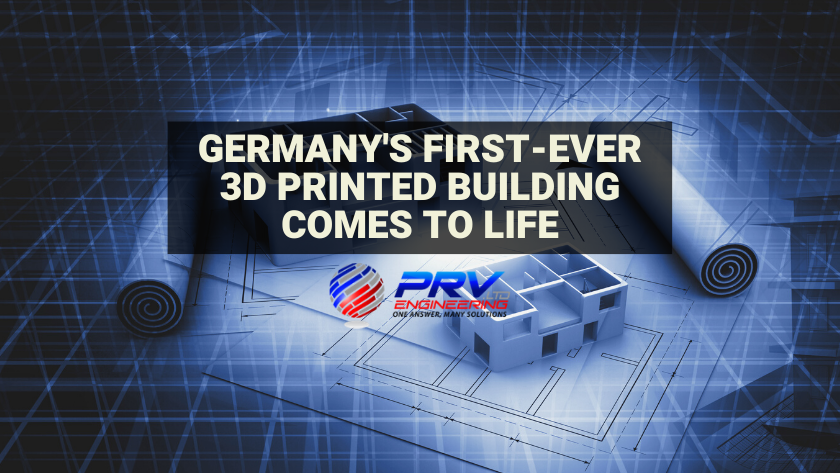
Technology is advancing at a rapid pace across all sectors and that includes construction. We’ve known for some time that a 3D printed building will make headlines once again and now, PERI GmbH is in the process of building Germany’s first 3D printed residential structure in Beckum, North Rhine-Westphalia. It’s only a short five weeks away from completion and it’s said to be a showstopper.
Printable Concrete For A 3D Printed Building
In September 2020, the construction of Germany’s first 3D printed residential building started in Bavaria marking what could be the first of many. The structure will certainly be a fascinating project accommodating five flats over three floors with around 4,000 ft² (380 m²) of living area. It’s being built using ‘BOD2’, regarded as the fastest 3D construction printer on the market.
It’s the first time Germany is using this construction technique which went through all the necessary regulatory approval processes. The engineering office Schießl Gehlen Sodeikat supported the development of the concept for obtaining the approval, planning and execution of the approval tests which the Technical University of Munich performed.
According to the press release, the 3D printed building was planned by MENSE-KORTE ingenieure+architekten and the client is Hous3Druck GmbH. In terms of the materials used, it’s a type of printable concrete from HeidelbergCement.
How Does The 3D Printer Work?
PERI, a family-owned building company joined forces with Danish manufacturer COBOD who supplied the 3D construction printer. It has a print head that travels along three axes on a strong metallic frame, allowing the printer to move anywhere within the structure.
It only needs to be calibrated once which helps save a considerable amount of time and money. Furthermore, the print head only needs two operators whilst the print results are watched on camera. The printer can also analyse pipes and connections for water, electricity, and other utilities that might be added later.
It works in such a way that printing and other tasks can take place within the printing area simultaneously. This means any manual task such as pipe installation and connections can be done without halting the construction (3D printing) process.
Creating The 3D Printed Building Of The Future
The 3D printed building is made up of triple-skin hollow walls filled with an insulating material. BOD2 doesn’t waste time either as it can complete 1 square meter of a double-skin wall in less than five minutes at a speed of 2.2 mph.
As mentioned earlier, the structure is printed using a substance created by HeidelbergCement called called ‘i.tech 3D’. They claim it has “excellent pumping and extruding characteristics” designed to meet the unique needs of 3D construction printing. An added benefit is that it works effortlessly with the BOD2 printer.
Once completed, they will rent all of the flats but one which will be a display unit. Considering the growing popularity of 3D printing, it appears there are plans for more 3D printed buildings taking shape within Germany’s distinct architecture.
The Impact Of Robots In Construction
In addition to this 3D printed building, robots are changing the construction industry as they are performing automated tasks quickly and safely. Many types are already in use performing tasks such as bricklaying, painting, loading and more. As time goes by, robots will likely be more prevalent in the future.
More importantly, using robots on a construction site can protect workers from dangerous environments and reduce injuries. They can also be used to complete tasks during labour shortages which can happen at any time.
Whilst the construction industry will always require a manual workforce, innovative robotics can certainly help speed up the process, reduce delays and improve productivity.
Recommended: ‘Advanced 3D Printing Technologies With NASA’
Technology For The Future Of Construction
The construction sector is constantly changing and improving with new methods, materials and technologies. This helps builders and contractors complete projects faster and safer while benefitting the end consumer. Here are some of the most innovative building materials that are only going to get better:
- Self-healing “bio-concrete” uses built-in sodium silica capsules that produce calcite to repair cracks automatically
- Carbon nanotubes with a thickness of 1 nanometre (one-billionth of a metre) have the highest strength-to-weight ratio of any material available today
- Transparent aluminium with the strength and malleability of metal but see-through like glass
- Aerogel is only 15 times heavier than air so this foam-like substance is extremely porous which gives it exceptional insulating properties
Of course, new materials are being developed for the construction industry every day so the possibilities are almost endless.
Share Your Thoughts On This 3D-Printed Building
After 100 hours of printing and ten months, Germany’s first-ever 3D printed building is taking shape and almost completed. With only a few weeks to go, the house will start showing visitors around from August so make sure you keep an eye on this story.
PRV Engineering has been a supplier of precision engineering and custom fabrication services to the construction industry for some time. We provide all sorts of services including structural and architectural steelwork, fabrication, site work and maintenance among others.
With extensive knowledge and experience in various industries, we regularly share articles on some of the latest developments in manufacturing, engineering and technology. Please follow and share posts from our blog and join the conversation on social media using the hashtag #PRVtech. We’d love to hear from you!


 Mail:
Mail: 



